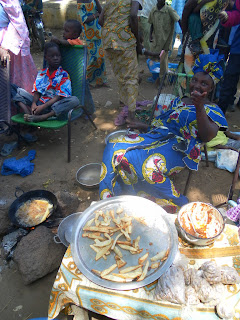November got away from us. The month opened with a Malian holiday and closed with an American one. We spent the first three weeks of the month in our village. The first weekend of November we celebrated Seli-Ba, aka Tabaski, the "Festival of the Sacrifice," the biggest Muslim holiday of the year in Mali.
While we have not researched the holiday in much depth, according to Wikipedia, Tabaski is a "religious holiday celebrated by Muslims worldwide to commemorate the willingness of Abraham to sacrifice his son as an act of obedience to God before God intervened to provide him with a sheep to sacrifice instead." In honor of the sacrifice, all Malian families who are able kill a sheep at home and share the meat with family and less fortunate neighbors. The day was filled with family time, religious blessings and lots of meat--liver and bread for a mid morning snack, grilled rib meat for lunch, stewed meat for dinner. Yum.
Seli-Ba Breakfast, Lunch and Dinner hanging from a tree in our host family's compound
The last week of November, we headed south to the region of Sikasso to celebrate Thanksgiving with our fellow PC Volunteers. Volunteers in the Sikasso region prepare a Thanksgiving feast every year - turkey, mashed potatoes, stuffing, green beans and pumpkin pie made from local squashes. Eight turkeys and three ducks were butchered the morning of Thanksgiving. Certainly the freshest turkey we have ever had.
George with the turkeys on Thanksgiving Eve. They had no idea what was coming...
No white linens or banquet tables for Thanksgiving this year. Just lawn chairs and boxed wine in plastic mugs. Turkey decorations courtesy of Tim and Lindsey's care package.
We are thinking of all of you this holiday season. Enjoy Advent. Stay Warm.


















































